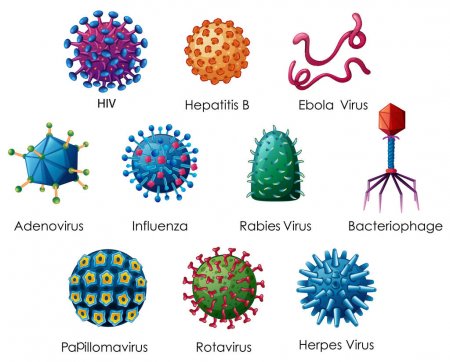¡¡
Picornaviruses family
¡¡
¡¡
Picornaviridae
In Fenner's Veterinary Virology (Fifth Edition), 2017
Classification
The family Picornaviridae is now included with the families Dicistroviridae, Iflaviridae, Marnaviridae, and Secoviridae in the Order Picornavirales. All viruses within this order share the following features: (1) conserved RNA-dependent RNA polymerase; (2) a genome that has a protein (VPg) attached to the 5¡ä end; (3) absence of overlapping open reading frames within the genome; and (4) viral RNA translated into a polyprotein before processing. Viruses within the families Iflaviridae, Marnaviridae, and Secoviridae infect only insects, plants, or algae and will not be considered further in this chapter. Viruses in the family Dicistroviridae infect insects and crustaceans, and the disease, designated as ¡°Taura syndrome,¡± has resulted in devastating losses in shrimp farms.
The family Picornaviridae has undergone a significant expansion in recent years, due principally to the identification of previously unknown picornaviruses by the ¡°next-generation¡± sequencing of clinical and environmental samples. The family is divided currently into 29 genera, of which 23 include only a single virus species. In addition to the well-established genera of Aphthovirus, Enterovirus, Teschovirus, Cardiovirus, Erbovirus, Kobuvirus, Hepatovirus, and Parechovirus, the identification and comparative analysis of new and existing picornavirus genomes has resulted in the creation of 21 new genera: Aquamavirus, Avihepatovirus, Avisivirus, Cosavirus, Dicipivirus, Gallivirus, Hunnivirus, Kunsagivirus, Megrivirus, Mischivirus, Mosavirus, Oscivirus, Pasivirus, Passerivirus, Rosavirus, Sakobuvirus, Salivirus, Sapelovirus, Senecavirus, Sicinivirus, and Tremovirus. The genus Enterovirus is the largest genus within the family and contains viruses with most relevance to human medicine; included in this genus are enteroviruses that use the gastrointestinal tract as the primary site of replication (eg, polio-, echo-, and coxsackie viruses), as well as the rhinoviruses that infect the upper respiratory tract. With the exception of the aphthoviruses that are yet to be changed, picornavirus species have been renamed recently to remove host species names that have been replaced with alphabetical assignments. Given the seemingly ever-changing and potentially confusing taxonomic organization of picornaviruses, coupled with the fact that taxonomic assignments do not consistently correlate with the biological behavior of individual picornaviruses (including the nature of the disease they induce in animals, if any), this chapter will be organized according to animal species rather than the taxonomic assignment of each virus. Important picornaviruses in human and veterinary medicine are listed in Table 26.1.
Table 26.1. Genera and Species of Picornaviruses Causing Important Diseases of Animals and Humans
Genus Virus Species Hosts Affected Disease/Comments
Aphthovirus Foot-and-mouth disease viruses Cattle, sheep, swine, goats, wildlife ruminant species Foot-and-mouth disease; 7 serotypes
Equine rhinitis A virus Horses, camelids Systemic infection with respiratory signs
Bovine rhinitis A virus Cattle Mild respiratory signs
Bovine rhinitis B virus Cattle Mild respiratory signs
Avihepatovirus Avihepatovirus A [Duck hepatitis A virus]a Duck Hepatitis
Cardiovirus Cardiovirus A [Encephalomyocarditis virus] Rodents, swine, elephants, primates, mammals in contact with rodents Encephalomyelitis and myocarditis in swine and elephants; rarely in other species; 2 serotypes
Cardiovirus B [Theilovirus] Rodents Murine poliomyelitis; 15 genotypes
Cardiovirus C [Boone cardiovirus] Rats Fecal isolation
Enterovirus Enterovirus A [Human enterovirus A] Human, simian Hand, foot-and-mouth disease, meningitis; 25 serotypes
Enterovirus B [Human enterovirus B] Humans Rash, respiratory disease, paralysis; 61 serotypes
[Swine vesicular disease virus] Swine Vesicular disease
Enterovirus C [Human enterovirus C] Human Poliomyelitis, Respiratory disease; 23 serotypes
Enterovirus D Humans, primates Respiratory disease, focal limb paralysis; 5 serotypes
Enterovirus E [Bovine enterovirus group A] Cattle Asymptomatic or mild enteric, respiratory, reproductive disease; 4 types
Enterovirus F [Bovine enterovirus group B] Cattle Asymptomatic or mild enteric, respiratory, reproductive disease; 6 types
Enterovirus G [Porcine enterovirus B] Swine, ovine Usually asymptomatic infection; 11 serotypes
Enterovirus H Simian Usually asymptomatic infection
[Simian enterovirus A]
Enterovirus J Simian Usually asymptomatic infection; 6 types
Rhinovirus A, B, and C [Human rhinovirus A, B, and C] Humans Respiratory disease; 80 (A), 32 (B), and 54 (C) serotypes
Erbovirus Erbovirus A [Equine rhinitis B virus] Equine Associated with mild rhinitis
Kobuvirus Aichivirus A [Aichi virus] Humans, canine, feline, rodents, birds Gastroenteritis, enteric infections
Aichivirus B [Bovine kobuvirus] Ovine, bovine, ferret Detected in feces and serum
Aichivirus C [Porcine kobuvirus] Swine Fecal detection
Megrivirus Melegrivirus A Chickens, turkeys, ducks Fecal detection, associated with hepatitis in turkeys
Sapelovirus Avian sapelovirus Ducks Hepatitis
Sapelovirus A [Porcine sapelovirus/porcine enterovirus A] Swine Diarrhea
Sapelovirus B [Simian sapelovirus] Simian
Teschovirus Teschovirus A [Porcine teschovirus] Swine Type 1; encephalomyelitis
Types 2¨C13; mild/asymptomatic
Tremovirus Tremovirus A [Avian encephalomyelitis virus] Chicken, pheasant, turkey, quail Encephalomyelitis
a
Parentheses[] indicate former (and often commonly used) names of individual viruses.
A significant difference among viruses in the various picornavirus genera is their stability at low pH; such differences were utilized in the classification of picornaviruses before molecular techniques were available. Specifically, the aphthoviruses are unstable below pH 7, whereas the enteroviruses, hepatoviruses, cardioviruses, and parechoviruses are stable at pH 3. However, other major similarities and differences were identified with the availability of complete genomic sequence data. All picornaviruses are single-stranded, positive-sense RNA viruses with a 5¡ä-untranslated region (5¡ä-UTR). The RNA is uncapped, but with a viral protein (VPg) covalently linked to the 5¡ä end. There are major structural differences in the 5¡ä-UTR among the genera of the picornavirus family: the length of the 5¡ä-UTR in picornaviruses varies from approximately 500 to 1200 nt and contains one of at least five different internal ribosome entry sites (IRESs). Cardioviruses, aphthoviruses, erboviruses, kobuviruses, teschoviruses, and sapeloviruses are among the 16 genera that are also distinguished by the presence of a leader protein (L) encoded upstream of the capsid proteins (Fig. 26.1). Foot-and-mouth disease virus, aquamavirus A, mosavirus A, and possibly passerivirus A all have multiple (2¨C3), but not identical VPg proteins that are present in equimolar amounts among the virion RNAs. Other virus species within each genus do not necessarily contain multiple copies of VPg.Picornaviridae - an overview | ScienceDirect Topics
https://www.sciencedirect.com/topics/neuroscience/picornaviridae¡¡

.jpg)